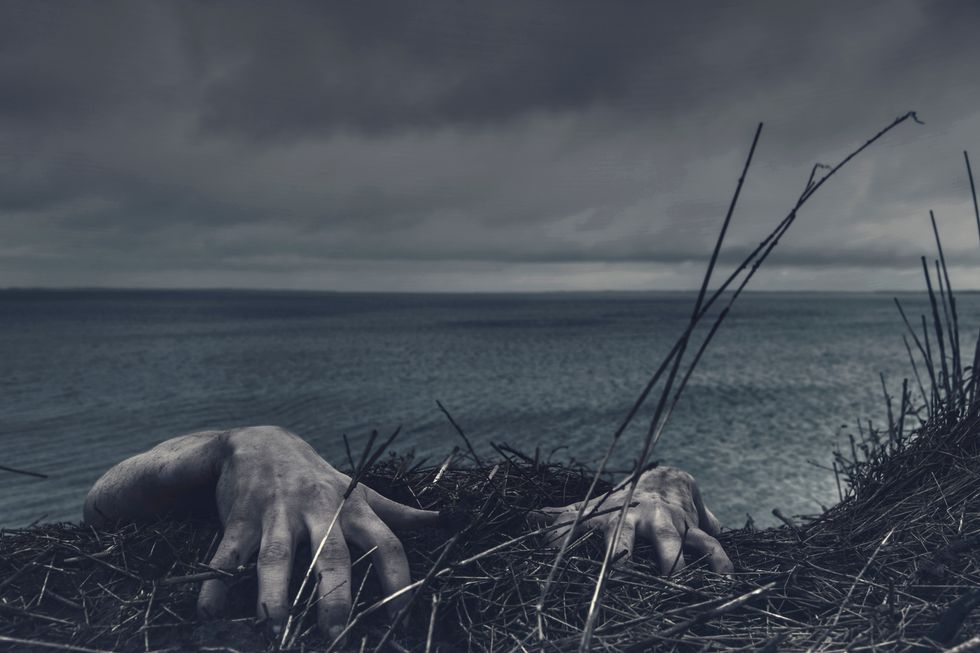Don't open that door!
Too late. Our blood-soaked heroine didn't think to turn the lights on or check the windows. She is now our lovely, headless heroine. C'mon... Couldn't she have posted on Facebook?
"Help! I'm currently being stalked by an 8-foot tall gremlin wearing a hockey mask and jorts. Call the police for me!"
Horror movies can be aggravating. From B-list actors to twists and turns that make us pull out our hair, they can be a lot to handle. Horror movies aren't a tremendously popular genre. In terms of market share, they clock in just below romantic comedies and only a few percentage points above musicals. They aren't adorned with praise at award ceremonies. Often, they are cheap to make. Many are an easy way to create a low-profit, high-return box office monstrosity. Despite that, the genre holds claim to countless classics: The Exorcist, The Thing, The Blair Witch Project and more recent hits such as It Follows and Jordan Peele's Get Out.
Some horrors movies make us jump in our seats, some wretch our stomachs, and others fall completely flat. That thing that goes bump in the night isn't just a clever editing trick, though. These are movies that reflect our society's greatest fears. Horror movies are looking glasses for the real anxieties that haunt our nightmares.
Stephen King, a master of suspenseful writing, has explained that horror films "serve as an extraordinarily accurate barometer of those things which trouble the night-thoughts of a whole society." Trends in horror are more than studio executives choosing vampires as the next terrifying fad. The monsters we create are channels for us to express the very real concerns that haunt us long after we leave the theater.
One of the earliest examples of horror cinema reflecting our anxiety is none other than "King Kong" (1933). The film, unfortunately, reflected the racism that pervaded American culture in the early 1900s. The image of a tribal beast coming to the cosmopolitan haven of Manhattan, climbing the skyscrapers in the face of the white citizenry, was more than just a spooky tale. It was a not-so-subtle reaction to a black population that was finally beginning to realize their own American dreams. To a racist and concerned populus, these were beasts descending upon their kingdom.
Another poignant example of the trend is "Invasion of the Body Snatchers" (1956), a classic film about a community of neighbors slowly being replaced by lifeless aliens who imitate their appearance. Terrifying? Certainly, but especially horrifying to an America that was obsessed with fears of communism - their loyal compatriots who had potentially been turned red by the maniacal arm of the Soviet Union. Fear of losing friends to a socialist darkness was at the heart of McCarthyism and the 1950s.
The trend hasn't ceased. The original "Godzilla" (1954) showcased a lizard turned demonic from a nuclear blast. Could the preceding dropping of the world's first atomic bomb had anything to do with the horror of radiation? George A. Romero's "Dawn of the Dead" (1978) features hordes of mindless zombies crawling through malls at the height of America's obsession with consumerism. The true fear in the masterpiece came not from the protagonists' concerns about becoming zombie-chow, but our own fear of becoming just like those mindless bodies.
Some of today's films are blatant in their approach towards the real horrors of the modern day. "Get Out" (2017) is a clever, head-on grapple with racism in our day and age. What spooky stories at your local cineplex are using a softer touch? Consider the B-movies that you brush off on Fandango. Some films may rely on screeches and jump scares, but a fine horror movie preys on us. It has watched us grow. It bides its time before lurching out of the shadows to tell us a story that chills us to the bone.






 The minimum wage is not a living wage.
StableDiffusion
The minimum wage is not a living wage.
StableDiffusion
 influential nations
StableDiffusion
influential nations
StableDiffusion











